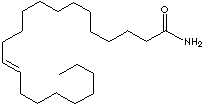Amide is a group
of organic chemicals with the general formula RCO-NH2 in which a carbon
atom is attached to oxygen in solid bond and also attached to an hydroxyl
group, where 'R' groups range from hydrogen to various linear and ring
structures or a compound with a metal replacing hydrogen in ammonia such as
sodium amide, NaNH2. Amides are divided
into subclasses according to the number of substituents on nitrogen. The primary
amide is formed from by replacement of the carboxylic hydroxyl group by the NH2,
amino group. An example is acetamide (acetic acid + amide). Amide is obtained by
reaction of an acid chloride, acid anhydride, or ester with an amine. Amides are
named with adding '-ic acid' or '-oic acid' from the name of the parent
carboxylic acid and replacing it with the suffix 'amide'. Amide can be formed
from ammonia (NH3). The secondary and
tertiary amides are the compounds which one or both hydrogens in primary amides
are replaced by other groups. The names of secondary and tertiary amides are
denoted by the replaced groups with the prefix capital N (meaning nitrogen)
prior to the names of parent amides. Low molecular weight amides are soluble in
water due to the formation of hydrogen bonds. primary amides have higher melting
and boiling points than secondary and tertiary amides. Anilide is an amide derived from aniline by substitution of an acyl group for
the hydrogen of NH2. Acetanilide is from acetic acid and aniline. Acetanilide is an odourless,
white flake solid or crystalline powder (pure form);
soluble in hot water alcohol, ether, chloroform,
acetone, glycerol, and benzene;; melting point 114 C and boiling point 304 C;
can undergo self-ignite at 545 C, but is
otherwise stable under most conditions. Acetanilide which can be obtained by
acetylation of aniline
undergoes
nitration at low temperature and yields highly the para-nitro products. Acetyl group can then be removed by acid-catalyzed hydrolysis to yield para-nitroaniline. Although the activating affection
of the
amino group can be reduced, the acetyl derivative remains an
ortho/para-orientation and activating substituent. Examples of
aromatic anilide are
benzanilide,
C6H5NHCOC6H5 or
Carbanilide (N,N'-diphenylcarbamide). Some structural amides are;
- Acetamides
- Acrylamides
- Anilides
- Benzamides
- Naphthylamides
- Formamides
- Lactams
- Salicylamides
- Sulfonamides
- Thioamides
- Fatty
amides
An amide is
hydrolyzed to yield an amine and a carboxylic acid under strong acidic
conditions. The reverse of this process resulting in the loss of water to link
amino acids is wide in nature to form proteins, the principal constituents of
the protoplasm of all cells. Acyl halides are the most reactive but amides the least reactive among
carboxylic acid derivatives, as in order of "acyl halides > anhydrides >
esters �� acids >
amides". In homogeneous solvent systems, amides react with
water only in the presence of strong acid or base catalysts under heating. Because of the nitrogen non-bonded electron pair with the carbonyl group, amides
are very polar and the basicity is weaker than amines. Electrophiles bond to
oxygen atom in preference to the nitrogen in an amide. One example of this
reaction is the production of nitriles by dehydration of primary amides when
treated with thionyl chloride. The addition of water to nitriles (carbon-nitrogen triple bond) gives an amide.
Sulfonamides are analogs of amides in which the
atom attached to oxygen in solid bond is sulfur rather than carbon. Sulfonamides react with alkyl halides, acid halides, sulfonyl halides,
epihalohydrins, ketones and aldehydes under basic conditions. Benzamide,
the simplest aromatic carboxylic amide, is used in the
synthesis of various organic compounds. Polyamide
is a polymer containing repeated amide groups such as various kinds of nylon and
polyacrylamides.
Erucamide,
unsaturated long
chain carboxylic
acid amide (22:1
n-9), is used as a
slip agent , anti-fogging or lubricant for plastic
films (polyolefin)
which can be used in food packing material. It is used as a dispersant in
printing and dying. It is used in paper and textile industry for water-proof
as well as corrosion inhibitor in oil wells. It is used for
the synthesis of organic chemicals and surfactants used in detergent, ore
floating agent, fabric softener, anti-static agent, germicide, insecticide,
emulsifier, anti-caking agent, lubricant and water treatment agent.
|
| Erucic
acid is the cis isomer of brassidic acid ( also called
cis-13-docosenoic acid belong to a monounsaturated
fatty acid) derived from rape seed, wallflower seed,
or mustard seed. It is insoluble in water but soluble
in ethanol and methanol. Erucic acid is used as an intermediate
to make chemicals such as triglycerides; erucamides;
amines, behenic acid; behenyl alcohol erucyl alcohol
, wide range of erucic acid metallic salts and
esters, brassylic acid and pelargonic acid. End applications
include lubricants, heat transfer fluids, surfactants,
slip agents, emollients, cosmetics and coatings. It
is also used in polyesters, plastics and nylons. |
